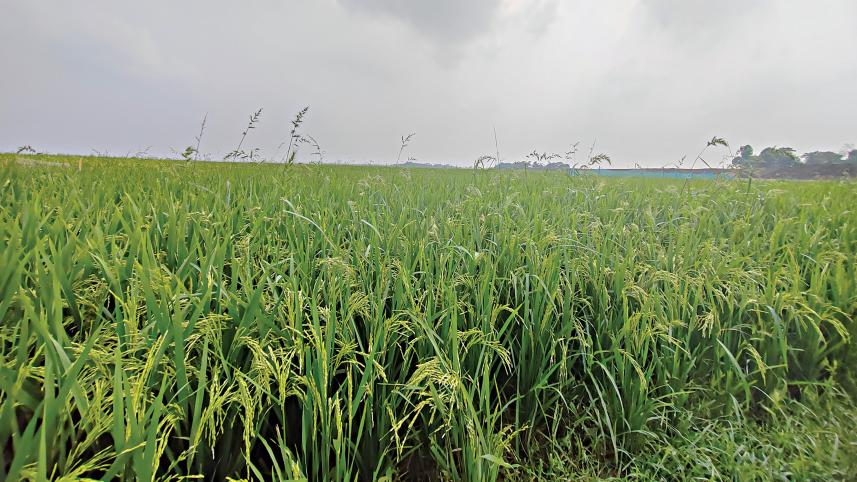Hope and fear in the haor

As farmers across the Sylhet division prepare for the boro paddy harvest, they aim for a good yield due to favourable weather and increased cultivation.
However, fears of flash floods and concerns over the quality of haor protection dykes threaten to dampen these expectations. Additionally, heat waves have triggered pest attacks and neck blast infections in some areas, raising further concern.
Israil Miah from Biraimabad in Moulvibazar Sadar upazila expressed hope for a good harvest after the last harvest was devastated by floods. "The paddy looks promising. I cultivated BRRI-29 and BRRI-89 varieties on 10 acres, and I'm expecting a good yield," he said.
Farmers cultivated boro on 497,219 hectares across Sunamganj, Moulvibazar, Sylhet, and Habiganj districts, slightly exceeding the target of 496,745 hectares.
The Department of Agricultural Extension (DAE) estimates a production of around 2,051,000 tonnes, valued at approximately Tk 10,250 crore.
The harvest will begin on a small scale from today, with full-scale harvesting commencing from April 15.
For many farmers in haor areas, boro is their only major crop, making this harvest crucial for their livelihood. Abdul Hossain, a farmer from Fulbari village in Sunamganj's Bishwambarpur upazila, said, "The sheaf of paddy has come out well due to the recent rainfall, but the threat of flash floods remains. The dyke that is meant to protect my harvest is still under construction and I am worried."
The haor regions are particularly vulnerable to flash floods, which originate from upstream areas in India. Heavy rainfall in Meghalaya and Assam can quickly inundate the low-lying fields of Sylhet. Since 2017, flash floods have been a major threat to boro production. Last year, repeated floods caused significant damage.
To mitigate early flooding, the government constructs and repairs haor protection dykes in Sunamganj annually. However, the quality and progress of these projects often raise concerns. This year, 593 kilometres of dykes are being built and repaired under 693 projects across 53 haors, costing Tk 128 crore, according to the Bangladesh Water Development Board (BWDB) in Sunamganj.
As per the Kajer Binimoye Taka (Kabita) Rules 2017, all dyke construction was to be completed by February 28, but even after an extended deadline, work remains unfinished. A visit to Korchar Haor on April 2 revealed incomplete dykes at Harimaner Bhanga in Raypur-Bhadarpur, with no workers in sight.
Nawshad Miah, a marginal farmer near the site, said, "Work stopped due to Eid, and we don't know when it will resume. With recent rain, we fear the worst."
Bijon Sen Roy, general secretary of the Haor Bachao Andolon, strongly criticised the construction quality. "This year's dyke construction is the worst in recent history. If heavy rains and flash floods come, most dykes will collapse, destroying the boro harvest."
However, BWDB officials downplayed the concerns.
Mamun Hawlader, the executive engineer of BWDB in Sunamganj and the member secretary of the district committee for dyke construction, claimed, "All basic work was completed on time, and overall progress is at 97 percent. Only finishing touches remain, and the quality is good. This year, we reinforced key dykes in seven upazilas with blocks, ensuring long-term stability."
Pest Attacks and Disease Outbreaks
While the overall crop condition is promising, some farmers have reported damage due to pest attacks and an outbreak of blast disease, primarily triggered by the recent weather.
"The paddy looks great this year, but insect infestation is a growing concern due to the humid yet hot weather," said Mohammad Jahangir of Moulvibazar Sadar Upazila, right after he sprayed pesticides on five acres of farmland.
The lack of soil moisture has created drought-like conditions in some areas, making fields vulnerable to pest attacks and fungal infections.
However, recent rainfall in Sylhet, Sunamganj, and Moulvibazar has helped mitigate these threats.
"The rain came at the right time, ensuring a better yield," said Bimal Chandra Shome, additional director of DAE in the Sylhet division.
However, he warned that Habiganj remains at risk due to a lack of rainfall.
Labour Shortage and Mechanisation
Another challenge this harvest season is the shortage of agricultural labour. Many rural workers have migrated to cities in search of better-paying jobs, making it difficult for farmers to find labourers.
"In recent years, young people have lost interest in farm work, and those available demand high wages," said Jyotimohon Das from Dosmontopur in Sunamganj's Dharmapasha upazila.
"Combine harvesters are an option, but there aren't enough in our area. Besides, if it rains heavily, they can't operate in muddy fields."
The government has deployed 1,700 combine harvesters across the division, said Bimal Chandra Shome.
"We are hopeful there will be no major labour shortage normally. Labour shortages usually arise when flash floods force farmers to harvest all at once," he said.
A Crucial Few Weeks Ahead
With full-scale harvesting approaching, farmers remain on high alert. Any unexpected heavy rain or upstream water flow could devastate their crops.
"We can't predict flash floods beyond 72 hours, which is always a concern," said Mamun Hawlader. "However, the next three days are expected to be safe."
Bijon Sen Roy added, "We can't prevent flash floods, but we can protect our crops with well-built dykes. This year, that is a real concern. We have held press conferences, submitted memorandums, and sent letters to concerned advisers. If the harvest is destroyed, we will stage massive protests to demand accountability."





 For all latest news, follow The Daily Star's Google News channel.
For all latest news, follow The Daily Star's Google News channel.
Comments